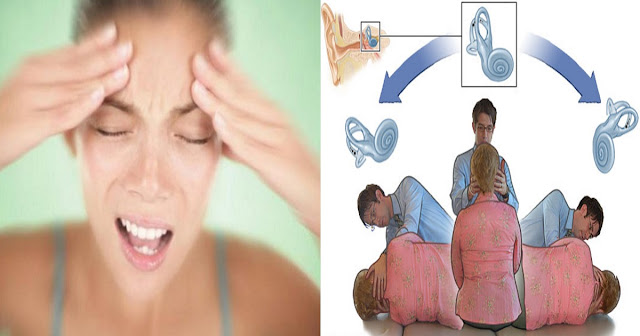The difference between vertigo and simple dizziness is that you or your environment seem to be moving. When it appears like your surrounding is moving, it is called objective vertigo. When you feel like you yourself are moving, it is called subjective vertigo.

Vertigo Symptoms
The following are the known symptoms of vertigo:
ü
Sensation of disorientation or motion
ü
Nauseas
ü
Vomiting
ü
Sweating
ü
Abnormal eye movements
ü
Hearing loss
ü
Ringing sesation in the ears
ü
Visual disturbances
ü
Weakness
ü
Difficulty Speaking
ü
Decreased level of consciousness
ü
Difficulty walking
ü
Loss of balance
#1: Hydrate
Have you been informed that sometimes, the simplest answer is the best one? You have to make sure that you are completely hydrated because even mild dehydration can lead to dizziness so always consume at least 8 to 10 glasses of water on a daily basis.
#2: Ginger
Ginger has been widely used in fighting against nausea and it can also provide the same benefits to those who are suffering from vertigo. Ginger root can significantly decrease the symptoms. You can actually consume this in a raw form, but it can be more pleasant to be made as a tea by simply putting the ginger root in a hot boiling water for at least 5 minutes in order to have a better taste, you can just add some honey.
#3: Vitamin D
Vitamin D is extremely beneficial for everyone that is diagnosed with vertigo. You can actually consult your doctor now in order to know whether your dizziness may be a reason behind vitamin deficiency.
#4: Gingko Biloba
It is the most researched herbs in the entire world and it is known for its ability to increase the vital blood of a human flow to the head. Just make sure to have a supplement that contains at least 245 gingko heterosides or ginkgolides then begin your treatment with about 200 milligrams on a daily basis in order to improve your vertigo. You can also lessen the dosage in between 60 to 40 milligrams every day in order to prevent it from returning.
#5: Daroff Exercise
Go to your bed and sit down. Tilt your head about 45 degrees away from the affected area. Lie down carefully on the affected side and keep your head in the same position so that your nose will be pointing upward. Hold it for at least 30 seconds and then sit up again and repeat the process on the other side. Practice this exercise for around thrice a day in order to subsidize your vertigo.
#6: Epley Maneuver
Step 1
You will sit on the doctor's exam table with your legs extended in front of you. The doctor will turn your head so that it is halfway between looking straight ahead and looking directly to the side that causes the worst vertigo. Without changing your head position, the doctor will guide you back quickly so that your shoulders are on the table but your head is hanging over the edge of the table. In this position, the side of your head that is causing the worst vertigo is facing the floor. The doctor will hold you in this position for 30 seconds or until your vertigo stops.
Step 2
Then, without lifting up your head, the doctor will turn your head to look at the same angle to the opposite side, so that the other side of your head is now facing the floor. The doctor will hold you in this position for 30 seconds or until your vertigo stops.
Step 3
The doctor will help you roll in the same direction you are facing so that you are now lying on your side. (For example, if you are looking to your right, you will roll onto your right side.) The side that causes the worst vertigo should be facing up. The doctor will hold you in this position for another 30 seconds or until your vertigo stops.
Step 4
The doctor will then help you to sit back up with your legs hanging off the table on the same side that you were facing.
This maneuver is done with the assistance of a doctor or physical therapist. A single 10- to 15-minute session usually is all that is needed. When your head is firmly moved into different positions, the crystal debris (canaliths) causing vertigo will move freely and no longer cause symptoms.
#7: Semont Maneuver
The Semont maneuver is done with the help of a doctor or physical therapist. A single 10- to 15-minute session usually is all that is needed. When your head is firmly moved into different positions, the crystal debris (canaliths) causing vertigo moves freely and no longer causes symptoms.
1.
First, you sit on the exam table with your legs
hanging off the edge.
2.
The doctor turns your head so that it is halfway
between looking straight ahead and looking away from the side that causes the
worst vertigo.
3.
The doctor then lowers you quickly to the side
that causes the worst vertigo. When your head is on the table, you are looking
up at the ceiling. The doctor holds you in this position for 30 seconds.
4.
The doctor then quickly moves you to the other
side of the table, without stopping in the upright position. When your head is
on the table, you are now looking down at the table. The doctor holds you in
this position for 30 seconds.
5.
The doctor then helps you sit back up.
Lack of sleep is one of the reasons that lead to vertigo. Therefore, sleep well, and most of your problems will go away.
Sources: eMedicine Health | WebMD | Home Remedy Shop
Share It To Your Friends!
Loading...





